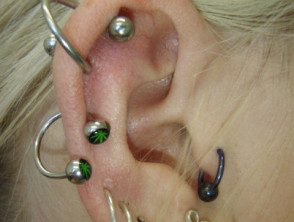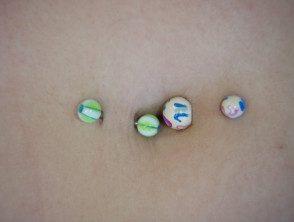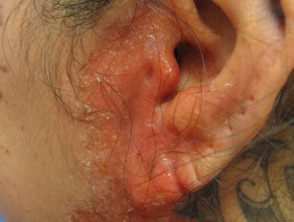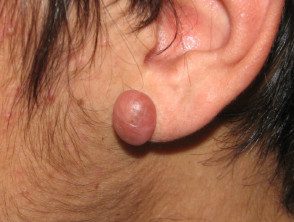What is body piercing?
Body piercing is the practice of creating an opening through a part of the human body to allow adornment with jewelry, metals, or cultural pieces, whether for temporary or permanent use.
Like tattoos, body piercing is a form of body modification. Related body piercing techniques include [1]:
- Gauging or Stretching – This is where larger diameter studs are attached across a piercing site every 4–6 weeks during healing to expand the hole created. A cultural variation of this is the stretching of the lips to encompass large discs. Heavy trims will also stretch the skin significantly over time.
- Pocket: In this technique, the ends of a semicircular ornament are embedded into the skin, leaving the middle of the object exposed.
- Microdermal or transdermal piercing: In this technique, an anchor is anchored under the skin. It has small holes through which tissue grows during healing. The jewelry is screwed into the anchor. This technique is sometimes called anchoring.
Body Piercings

Earrings

Navel jewelry

tongue stud
Who undergoes body piercing?
Body piercing is seen in various cultures and has been practiced for thousands of years. In Western populations, their predominance falters dramatically. Its popularity is determined by the reasons why people decided to get a piercing; for example, feeling unique, for aesthetic reasons, eroticism or conformity, or as a form of rebellion or self-controlcontrol.
the incidence Body piercing is higher in young adults and women. It correlates with increased risk-taking behavior and a search for identity. [2,3], but not with psychopathology or low self-esteem [4]. Multiple piercings (>4) and/or intimate piercings, such as nipples or genitals, increase the risk of concurrent high-risk behaviors and emotional distress [5].
Traditional forms and uses of body piercing continue to be practiced throughout the world, including in religious customs and cultural ceremonies that incorporate spiritual beliefs and/or culture-specific symbolism. Traditional therapeutic Piercing uses include scarification and acupuncture-like piercing; For example, left nasal piercing in Ayurvedic medicine is believed to reduce the pain of menstruation and childbirth. On the contrary, piercings placed at specific points have been blamed for health problems and infertility.
Maori and Pacific peoples may use bones or other traditional materials for cultural piercings [6]. Piercing techniques, embellishments, and potential complications from traditional piercing vary considerably. Fundamental in all cases is the importance of infection control measures and, when necessary, respectful and culturally competent medical management.
Body piercing is also performed surgically to insert a magnetic tongue bar in individuals with tetraplegia to assist with the use of tongue operated assistive technology. [7].
Which are the contraindications to body piercing?
Materials known to cause allergy – including anaphylaxis – should be avoided in people undergoing body piercing, including medical devices typically used in the procedure (e.g., nickel-plated items, latex surgical gloves).
Strong contraindications
Body piercing is strongly contraindicated in individuals with local infection or inflammatory disease, including:
- Previous hypersensitivity reaction to any associated material.
- Tooth decay or gum disease: for oral piercings
- Eczema and psoriasis
- sexually transmitted infection
Moderate contraindications
Body piercing is moderately contraindicated in individuals with the following conditions or circumstances:
- Family or personal history of keloid scars, especially if they are older than 11 years.
- Valvular heart disease: for oral perforations
-
Immunocompromise [8]
- Uncontrolled diabetes mellitus [9]
- Uncontrolled bleeding disorder
- Pregnancy: for abdominal and genital piercings, as pregnancy can lead to implant rejection [10], tears and scars
- Breastfeeding – for nipple piercings; existing perforations can also cause problems [11]
- The lack of immunization hepatitis yes
- Need for orthodontic treatment, due to increased risk of hypersensitivity reaction to nickel [12]
- Anemia, smoking and/or poor nutrition: can delay wound healing
Body piercing regulations
Body piercing is widely considered a simple procedure, with potential complications that providers and their clients do not recognize. [6,13,14]. Commercial body piercing (not including regular ear piercing) is usually performed in tattoo studios and non-commercial piercing “backyard jobs” are not uncommon [6,14].
The establishment and regulation of industry standards for body piercing, under the general domain of public health, is the responsibility of the relevant territorial authorities. The New Zealand Ministry of Health provides Guidelines for safe skin piercing. [6], which can form the basis of any local standards or serve as a resource for providers and their customers where local government standards do not exist.
In New Zealand, few regulatory standards are outlined or enforced. Most councils have age restrictions on body piercings, and interested people must be at least 16 or 18 years old. Teens can undergo body piercing before this age when providers receive written parental consent. With the exception of ear piercing where infants and children (usually girls) can have their ears pierced with parental consent, body piercing in this age group is unregulated and unreported.
Intoxication and peer pressure can independently affect an individual's decision to undertake the procedure. People interested in undergoing body piercing should educate themselves on the topic and evaluate the risks; Visiting multiple providers (to review sanitation, ask questions, and review reviews) is highly recommended.
The body piercing procedure
Pre-procedure
- The client's medical history should be recorded prior to the procedure so that any necessary changes can be made accordingly (e.g. ensuring a latex-free environment for the procedure, client undergoing hepatitis B vaccine, antimicrobial prophylaxis being provided).
- After the procedure is explained, written informed consent is obtained from the client.
- The environment in which the procedure will be carried out is prepared.
- The equipment necessary for the procedure is prepared.
- This kit should include sterile supplies appropriate for the procedure and any early complications (eg, bleeding).
- Quality disposable/disposable equipment is recommended. This should be opened immediately before use and disposed of in sharps or biohazard containers.
- Special care must be taken with cleaning solutions and fluids to avoid contamination, as they are often reused and can transmit infections.
- Expiration dates for all equipment must also be met.
Process
- The client's skin should be clean and free of infection or inflammation. Shaving the skin to remove the body hair it can be necessary
- The client's skin is disinfected. Povidone iodine is used around the eyes; Elsewhere, the New Zealand Ministry of Health recommends alcohol solutions, alcohol plus chlorhexidine, alcohol or aqueous detergent plus povidone-iodine. Guidelines for safe skin piercing. [6].
- The particular technique of body piercing is performed.
- Piercers can use a 12–16 gauge hollow gauge needle to pierce the skin, guide the jewelry through the needle with a string or wire, and then remove the needle [1].
- Simple holes can be made with a spring-loaded gun. Piercing guns are often the preference of non-specialized body piercing providers. These piercing guns cannot be fully sterilized and are not recommended as they may increase trauma and complications such as infection.
- A clean, waterproof wound dressing is applied to the piercing.
Postoperative cure
Once the procedure has been performed, the pierced individual should avoid public pools and spas due to the risk of infection. Contact with the drilling site should be avoided in addition to cleaning. Cleaning should be done once or twice a day with antimicrobial soap and water. Oral piercings should be cleaned with an antiseptic, alcohol-free mouthwash. Ice can be used to reduce swelling. Intimate piercings and alternative piercing types require special care.
Healing times vary and are affected by piercing location, individual client factors, and aftercare. Any pus, continued bleeding, or other concerns should be reviewed by a medical professional.
What are the side effects and risks of body piercing?
The lack of regulation and reporting of incidents (especially with respect to sensitive or high-risk piercings) means that estimates of the incidence of adverse effects of body piercing are inconsistent and unreliable [14].
Immediate complications of the body piercing procedure can include:
- Bleeding: Bleeding after piercing can take minutes (earlobe) to days (genital) to stop
- Pain, as piercing is rarely done with anesthetic
- Nausea: The pain experienced can lead to nausea.
Cutaneous Adverse effects
The following adverse skin effects may occur.
Contact dermatitis
-
Allergic contact dermatitis is the most common non-infectious skin complication.
-
Nickel is the most common allergen [1,14].
- Multiple piercings increase the risk of contact dermatitis.
- Nickel-containing orthodontic treatment (before drilling) decreases the risk [12].
- The use of hypoallergenic metal items (e.g., surgical stainless steel, niobium, titanium, or gold) is recommended, particularly in the period from piercing to resolution of healing. [1,14].
- Irritating Contact dermatitis can occur from the cleaning solutions used.
- Treatment involves removal of the ornament or cleaning. solution and its future avoidance.
Keloids and hypertrophic scars
- There is a greater chance of keloid and hypertrophic scars if there are post-procedure complications (such as hematoma, infection and excess skin tension) and/or delayed wound healing.
- People over 11 years of age with a family history or personal history of keloid or hypertrophic scars are at increased risk [1,15].
- Hypertrophic scars usually occur 4 to 8 weeks after injury, increase in size for up to 6 months, and then flatten within a few years. [fifteen].
- Keloid scars can develop up to several years after the body piercing procedure and may continue to grow in size beyond the size of the original wound into the client's adulthood. Keloid scars occur mainly during adolescence. [fifteen].
- Such scarring can be reduced with prophylactic silicone gel foils or injection of intralesional corticosteroids [14,15].
Granuloma
- Once recognized, foreign body granuloma, a chronic inflammatory condition, can be treated with intralesional injection of corticosteroids.
Complications of body piercing

Contact dermatitis to disinfectant

Blue discoloration of penetrating scar

Keloid scar at ear piercing site.
Infectious complications
Penetration of the skin barrier with body piercing exposes underlying tissues. With body piercing, wound healing is slow due to the presence of a foreign body (the piercing jewelry), and in cartilage piercings, the blood supply is poor. The risk of infectious complications is greater in deep perforations and in those mucous membrane surfaces Oral infections can also swell and occlude the client's airway perforation.
The list of possible infectious complications includes:
- Abscess
- Cellulitis
- Chondritis
- Septicemia
- Brain abscess: due to oral perforation
- Infectious endocarditis – oral piercing
- Toxic shock syndrome – Genital piercing.
The most frequently isolated pathogens They are Pseudomonas aeruginosa and Staphylococcus aureus. Possible viral infections include hepatitis B, hepatitis C, and human immunodeficiency virus (HIV) As a precaution, body piercing clients should not donate blood for 6 months after piercing procedures.
psychological effects
Body piercing can have psychological effects on people who undergo the procedure.
- Where it is necessary to remove piercings, it may be psychologically traumatic, especially when the piercings were achieved for reasons such as identity, resistance, spirituality or remembrance. Use of suture material, non-stick posts, or non-metallic catheters to maintain the body piercing opening [1,16] If the removal is intended to be temporary, it may provide the individual with some peace of mind.
- The deformity that can occur with piercings can reduce self-esteem and body confidence.
- Individual disinterest leads to the intentional 13 to 18% removal of body piercings at body sites other than the earlobes in Western culture [1].
- People undergoing body piercing procedures may face discrimination and stigma stemming from incorrect assumptions about the piercing, differing personal opinions, or failure to adhere to staff dress codes and expectations around appearances.
Trauma
- Local structures may be damaged during body piercing.
- Oral piercings can cause gingival recession, chipping of teeth or fracture of dentures. They can also increase salivation, interfere with feeding, and cause speech impediments. [1,17].
- Los piercings en los pezones y los genitales pueden causar traumatismos durante la lactancia y las relaciones sexuales, respectivamente. [11].
- La fuerza física puede desalojar un piercing y provocar lagrimeo, sangrado, hinchazón y / o dolor como complicaciones comunes. Las perforaciones orales o nasales desalojadas pueden provocar que el adorno se trague o inhale en los pulmones. [17,18].
- El daño a los tejidos puede causar deformidad física. Las perforaciones genitales pueden alterar el flujo sanguíneo urinario o causar priapismo en los hombres, y las cicatrices, especialmente después de la infección, son desagradables. La cicatrización en el área genital puede causar infertilidad en casos raros [17].
Complications during investigations and surgery.
- Las perforaciones pueden oscurecer las imágenes durante una radiografía o computed tomography scan.
- Dependiendo de la composición del metal, algunos piercings pueden moverse o extraerse por fuerza magnética durante magnetic resonance image. Cualquier perforación capaz de conducir electricidad debe eliminarse para la cirugía, ya que pueden producirse quemaduras eléctricas con electrocauterización. [16].
- Las perforaciones orales o nasales, o la hinchazón secundaria, pueden obstruir la intubación durante un anestesia general. Las perforaciones desprendidas pueden tragarse, incrustarse o inhalarse en los pulmones. [17,18].
- Los riesgos quirúrgicos incluyen desgarro, infección y daño en el sitio de perforación, o complicaciones debido a la deformidad física resultante (por ejemplo, la colocación de orina catheter donde el flujo urinario ha sido alterado debido a la presencia de un piercing) [17].
- Los médicos y las enfermeras no reciben capacitación rutinaria en el manejo seguro de los piercings corporales, ni es necesariamente intuitivo. [17,18].
